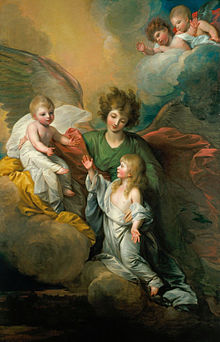Prince Alfred of Great Britain
| Prince Alfred | |
|---|---|
Lower Lodge, Windsor Great Park, England | |
| Burial | 27 August 1782 |
| House | Hanover |
| Father | George III |
| Mother | Charlotte of Mecklenburg-Strelitz |
Prince Alfred of Great Britain (22 September 1780 – 20 August 1782)
Life
Prince Alfred was born on 22 September 1780, at
Death and aftermath

During the time of Prince Alfred, smallpox was a disease dreaded by royalty and commoners alike,[10] and due to a lack of medical development, it was frequently fatal.[11] Queen Charlotte, Alfred's mother, was a lifelong advocate of inoculation, and she had the royal children undergo the procedure.[12] Variolation, its precursor, was popularised in Britain when the daughters of King George II, then Prince of Wales, underwent the procedure in 1721.[13]
In 1782, Prince Alfred was inoculated against smallpox. The inoculation had a negative effect on the Prince's health. Alfred's face and eyelids suffered from eruptions caused by the inoculation, and his chest was also in poor condition.
Although the household did not go into mourning (it was not prescribed for royal children younger than seven),
The first of George III and Queen Charlotte's children to die,[24][36] Alfred died in 1782, whereas his older sister Princess Mary, who was the last survivor of George III and Queen Charlotte's fifteen children, died in 1857.[37] Alfred is also unique among their first fourteen children for never being an older sibling while he was alive, as the only child younger than him was born after his death.[38]
Title and style
Throughout his life, Alfred was
Ancestry
| Ancestors of Prince Alfred of Great Britain Princess Charlotte of Mecklenburg-Strelitz | | ||||||||||||
|---|---|---|---|---|---|---|---|---|---|---|---|---|---|
| 14. Ernest Frederick I, Duke of Saxe-Hildburghausen | |||||||||||||
| 7. Princess Elisabeth Albertine of Saxe-Hildburghausen | |||||||||||||
| 15. Countess Sophia Albertine of Erbach-Erbach | |||||||||||||
Notes
- ^ Jeremy Black lists these conversations occurring in 1812; Kenneth Panton believes they happened the previous year, in 1811.[24]
References
- ^ Curzon 2020, p. XII.
- ^ a b Weir 2008, p. 300.
- ^ a b Hall 2010, p. 236.
- ^ Hedley 1975, p. 344.
- ^ Hadlow 2014, p. 192.
- ^ Sheppard 1894, p. 59.
- ^ Watkins 1819, p. 276.
- ^ Fraser 2004, p. 65.
- ^ a b Hadlow 2014, p. 291.
- PMID 16200144.
- ^ Koplow 2003, p. 9.
- ^ Hedley 1975, p. 99.
- ^ Koplow 2003, p. 17.
- ^ a b c d Fraser 2004, p. 71.
- ^ Watkins 1819, p. 282.
- ^ Hadlow 2014, pp. 291–292.
- ^ a b Hadlow 2014, p. 292.
- ^ Fraser 2004, pp. 72–73.
- ^ a b "No. 12324". The London Gazette. 20 August 1782. p. 1.
- ^ Hedley 1975, p. 126.
- ^ Holt 1820, p. 251.
- ^ a b c d Fraser 2004, p. 72.
- ^ "RA GEO/ADD/15/443a-b – Letter from Queen Charlotte to Lady Charlotte Finch, probably August 1782". Georgian Papers Project. Royal Collection Trust. Retrieved 3 February 2017.
- ^ a b c Panton 2011, p. 39.
- ^ "Royal Burials in the Chapel since 1805". College of St. George. Archived from the original on 27 September 2011.
- ^ "Royal Burials in the Chapel by location". College of St. George. Archived from the original on 22 January 2010.
- ^ a b Black 2006, p. 156.
- ^ Fraser 2004, pp. 74–77.
- ^ Hedley 1975, p. 127.
- ^ Black 2006, p. 256.
- ^ Curzon 2020, p. 86.
- ^ Walpole & Cunningham 1891, p. 363.
- ^ Hadlow 2014, p. 293.
- ^ Fraser 2004, p. 73.
- ^ Hadlow 2014, p. 296.
- ^ Hibbert 2000, p. 99.
- ^ Fraser 2004, pp. xii–xiii, 399.
- ^ Fraser 2004, pp. xii–xiii, 74–75.
- ^ von Ammon 1768, p. 5.
Bibliography
- ISBN 0-300-11732-9.
- Curzon, Catherine (2020). The Elder Sons of George III: Kings, Princes, and a Grand Old Duke. Pen & Sword Books Limited. ISBN 978-1-4738-7250-9.
- ISBN 0-7195-6108-6.
- Hadlow, Janice (2014). A Royal Experiment: The Private Life of King George III. Henry Holt and Company. ISBN 978-0-8050-9656-9.
- Hall, Matthew (2010) [1858]. The Royal Princesses of England: From the Reign of George the First. G. Routledge & Co. ISBN 978-1-146-51884-0.
- Hedley, Olwen (1975). Queen Charlotte. J. Murray. ISBN 0-7195-3104-7.
- ISBN 0-465-02724-5.
- Holt, Edward (1820). The Public and Domestic Life of His Late Most Gracious Majesty, George the Third, Volume 1. London: Sherwood, Neely, and Jones. OCLC 765811244.
- Koplow, David A. (2003). Smallpox: The Fight to Eradicate a Global Scourge. Berkeley: University of California Press. ISBN 978-0-520-24220-3.
- Panton, Kenneth J. (2011). Historical Dictionary of the British Monarchy. Scarecrow Press, Inc. ISBN 978-0-8108-5779-7.
- Sheppard, Edgar (1894). Memorials of St. James's Palace, Volume 2. London: Longmans, Green, and Co. OCLC 1166804665.
- von Ammon, Christoph Heinrich (1768). Genealogie ascendante jusqu'au quatrieme degre inclusivement de tous les Rois et Princes de maisons souveraines de l'Europe actuellement vivans [Genealogy up to the fourth degree inclusive of all the Kings and Princes of sovereign houses of Europe currently living] (in French). Bourdeaux: Frederic Guillaume Birnstiel. OCLC 12016472.
- OCLC 609155242.
- OCLC 4606736.
- ISBN 978-0-09-953973-5.
External links
 Media related to Prince Alfred of Great Britain at Wikimedia Commons
Media related to Prince Alfred of Great Britain at Wikimedia Commons- Portraits of Prince Alfred at the National Portrait Gallery, London
